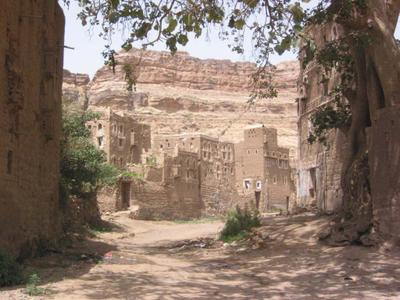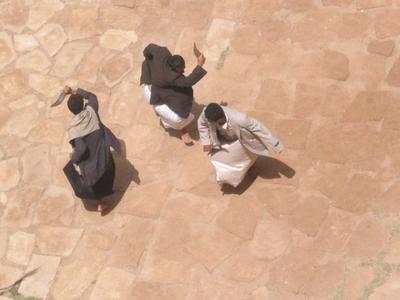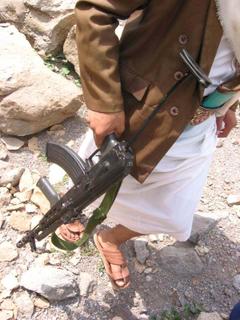Wadi Da' Trip

Wadi Da' is an idyllic valley north-west of Sana'a, where the Imam (who used to rule the country as the religious and political leader until he was ousted a couple of decades ago) had a big house on top of a rock, where he lived in the summers. The village above, underneath his house is a typical example of a Yemeni village, built entirely out of mud-bricks or rough-cut stones, and painted white especially around the windows, giving it the typical Yemeni touch. Sorry if this sounds like an excerpt of a guide book... (-;
 This and the next picture show the house of the Imam, called "Daar al-Hejar", which means as much as 'house of the stone'. It's quite spectacular and attracts big crowds of tourists, luckily mostly Yemeni, though. I also saw a small Japanese group there and one of them was such a styler, could have walked straight off the set of "Lost in Translation" - in the Japanese rebel-schoolboy look: white shirt - buttened up, black tie, mushroom-hair, tight black jeans around his tiny waist and then big black paratrooper-boots, pushing the end of the jeans up over his shins, a cool leather laptop-bag over his skinny shoulders. With all that and his minimal black sunglasses he looked so completely removed from that place, so without any relation to it at all. And then there was me, trying so hard to fit in: turban, skirt-type thing and belt & dagger around my waist. It's funny actually, while I'm trying to look Yemeni, most of the young people I meet here (especially the wealthier ones in Sana'a, not so much in the country) are trying similarly hard to look European/Western - with tight, overly-coloured and -patterned jeans, funky shirts and gel-soaked and -styled hair. Anyway.
This and the next picture show the house of the Imam, called "Daar al-Hejar", which means as much as 'house of the stone'. It's quite spectacular and attracts big crowds of tourists, luckily mostly Yemeni, though. I also saw a small Japanese group there and one of them was such a styler, could have walked straight off the set of "Lost in Translation" - in the Japanese rebel-schoolboy look: white shirt - buttened up, black tie, mushroom-hair, tight black jeans around his tiny waist and then big black paratrooper-boots, pushing the end of the jeans up over his shins, a cool leather laptop-bag over his skinny shoulders. With all that and his minimal black sunglasses he looked so completely removed from that place, so without any relation to it at all. And then there was me, trying so hard to fit in: turban, skirt-type thing and belt & dagger around my waist. It's funny actually, while I'm trying to look Yemeni, most of the young people I meet here (especially the wealthier ones in Sana'a, not so much in the country) are trying similarly hard to look European/Western - with tight, overly-coloured and -patterned jeans, funky shirts and gel-soaked and -styled hair. Anyway.
 Traditionally, weddings in Sana'a happen on Thursday nights (the first day of the weekend here) and on Friday mornings the bridegroom and his male companions make a trip to Wadi Da' and perform the Janbia-dance under the "Daar al-Hejar". It is one of the few times in the life of a Yemeni man, that the dagger is actually drawn, other than to show it to friends. The dancing itself isn't really as spectacular as I'd hoped for -- quite slow, but it looks terribly funny to see a bunch of men waving big daggers around and running after each other in a circle, especially when viewed from above. The fact that every other Yemeni man (in villages probably more like 80%) is armed with at least a dagger, does have some consequences. I wouldn't say that it makes the place insecure for foreigners, quite the contrary, actually, but if a personal conflict or family feud between Yemenis DOES ever escalate, the obvious thing after the first few punches have been exchanged - is to draw the Janbia. So it is one of the more common causes of an unnatural death here.
The presence of fireweapons is a bit of a different issue. A recent law in Sana'a forbids people to carry guns in public except if they have a specific permission to do so, i.e. if they're either in the army, or work as guards for the many embassies, sheikh's homes and random rich people's residences. Still one sees them around and only yesterday a man got into one of the little Suzuki-buses with a classic AK-47 in his hand. His dress didn't distinguish him noticably from the other passengers and everybody seemed at ease with the presence of that weapon in the car. I'm not really alarmed anymore either, it has almost become normal.
Traditionally, weddings in Sana'a happen on Thursday nights (the first day of the weekend here) and on Friday mornings the bridegroom and his male companions make a trip to Wadi Da' and perform the Janbia-dance under the "Daar al-Hejar". It is one of the few times in the life of a Yemeni man, that the dagger is actually drawn, other than to show it to friends. The dancing itself isn't really as spectacular as I'd hoped for -- quite slow, but it looks terribly funny to see a bunch of men waving big daggers around and running after each other in a circle, especially when viewed from above. The fact that every other Yemeni man (in villages probably more like 80%) is armed with at least a dagger, does have some consequences. I wouldn't say that it makes the place insecure for foreigners, quite the contrary, actually, but if a personal conflict or family feud between Yemenis DOES ever escalate, the obvious thing after the first few punches have been exchanged - is to draw the Janbia. So it is one of the more common causes of an unnatural death here.
The presence of fireweapons is a bit of a different issue. A recent law in Sana'a forbids people to carry guns in public except if they have a specific permission to do so, i.e. if they're either in the army, or work as guards for the many embassies, sheikh's homes and random rich people's residences. Still one sees them around and only yesterday a man got into one of the little Suzuki-buses with a classic AK-47 in his hand. His dress didn't distinguish him noticably from the other passengers and everybody seemed at ease with the presence of that weapon in the car. I'm not really alarmed anymore either, it has almost become normal. In the country things are different. One still finds older farmers, who carry a bunduqiya (long rifle-like weapon, of ancient origin) with them, when they go into the fields. Last weekend I went on a trip to the area of Manakha with a group of ex-Pats and other Arabic students and found myself walking through the mountains, that are carefully terrassed to make best use of the scarce water, with an AK-47 dangling over my shoulder. Earlier in the day, when we drove into the village around which we went hiking later, there was a group of men crowded around a bridegroom on the side of the street. He was parading with a long sword in a golden and beautifully decorated sheath and at the edge of the crowd stood a young boy, maybe 13 years old, with his arms resting on a black Kalashnikov, strapped over his shoulder.
The driver of the Malaysian vice-ambassador who was part of the group, had an Israeli-made hand-gun in a holster attached to his beautifully embroidered waist-belt, which also held his Janbia. "Why are you carrying a gun?" I asked him. I had asked this question a number of people before and the answer is always more or less the same: "For protection, just in case there's trouble." This doesn't mean that it will act as a means of self-defense in the obvious sense, but rather as a kind of weight to be presented against that of possible aggressors or road-cutters, as they're called in the Arabic langauge. They are rare, but apparently do exist, especially in very tribal areas and in the Bedouin part in the North-East of the Yemen, but will show no aggression if they see that you have a gun in your possession.
 So it's quite a rough and traditional society in that sense, and it is partly what gives it the impression that it hasn't changed a great deal over recent centuries. It feels like the Arabia that was marvelled about by British expeditioners some two centuries ago, where you found incredible hospitality and a devout and friendly society, but have to be prepared for the harshness of desert life and the general unexpected at any moment. When we think of "an Arab" these days, I think we are more likely to imagine a tall, rich Saudi in a long, wide and white dress, than a bearded Yemeni in a cream coloured thaub with a belt around his waist, a dagger in front of his belly and a gun over his shoulder, are we? But to me the latter is much more appealing and feels more like a real, original Arab.
So it's quite a rough and traditional society in that sense, and it is partly what gives it the impression that it hasn't changed a great deal over recent centuries. It feels like the Arabia that was marvelled about by British expeditioners some two centuries ago, where you found incredible hospitality and a devout and friendly society, but have to be prepared for the harshness of desert life and the general unexpected at any moment. When we think of "an Arab" these days, I think we are more likely to imagine a tall, rich Saudi in a long, wide and white dress, than a bearded Yemeni in a cream coloured thaub with a belt around his waist, a dagger in front of his belly and a gun over his shoulder, are we? But to me the latter is much more appealing and feels more like a real, original Arab.
Every Yemeni, so I've been told, has at least one Kalashnikov in his home. That might seem weird to us and might make the Yemen sound like a dangerous place to go to, but then nobody has ever had any concerns about travelling to Texas, have they? (-;


0 Comments:
Post a Comment
<< Home